Optimal Allocation of Energy Storage Capacity in Microgrids Considering the Uncertainty of Renewable Energy Generation
Abstract
1. Introduction
- (1)
- In order to solve the problem of energy storage capacity allocation of microgrids under the scenario of uncertain renewable energy generation, a double-layer optimization allocation model of energy storage capacity of microgrids is constructed by taking a multi-day typical scenario as the simulation operation scenario. The upper layer aims to optimize the energy storage allocation capacity by minimizing the expected annual total cost of centralized operation of the microgrid in multi-day typical scenarios, and the lower layer aims to optimize the microgrid operation plan under each typical scenario by minimizing the operation cost;
- (2)
- In view of the uncertainty and high dimension of renewable energy generation, a scenario generation method combining CGAN and LHS with a long dispatching period was proposed. CGAN was used to excavate the output characteristics of renewable energy under each daily state type, and LHS was used to stratify sampling to avoid the large deviation between the occurrence frequency of each daily state and the true probability in the typical scenario set. At the same time, intra-day and inter-day scheduling of energy storage can be fully considered.
2. Energy Storage Capacity Allocation Model of Microgrid
2.1. Objective Function
2.2. Constraint Condition
3. Model Solving Process
3.1. Scenario Generation of Daily Net Generation Power Based on CGAN
3.2. Scenario Generation of Multi-Day Net Generation Power
3.3. Multi-Day Scenario Reduction
3.4. Double-Layer Optimal Allocation Model Solving
4. Example Analysis
4.1. Example Parameter
4.2. Simulation Results and Analysis
4.2.1. Comparison of Generation Methods for Typical Scenarios of Net Generating Power
4.2.2. Energy Storage Capacity Optimization Allocation Results and Analysis
4.2.3. The Ability of Microgrids to Cope with The Uncertainty of Renewable Energy Generation under Different Algorithms
5. Conclusions
- (1)
- In the process of energy storage capacity allocation in microgrids, the proposed double-layer optimal allocation model of energy storage capacity in microgrids comprehensively considers the influence of daytime and intra-day scheduling strategies on the allocation problem, which ensures the operation economy and relieves the grid-connected pressure of net generation power;
- (2)
- The generation method of typical scenarios of multi-day net generation power proposed can still restore the real situation of daily state probability density distribution when the number of typical scenarios is small. The time correlation and uncertainty of renewable energy generation are explored by using CGAN to avoid the assumption that renewable energy generation obeys a certain probability distribution.
Author Contributions
Funding
Institutional Review Board Statement
Informed Consent Statement
Data Availability Statement
Conflicts of Interest
Appendix A
| Parameter | Value |
| CNY 1000 per kWh | |
| CNY 3500 per kW | |
| 0.067 | |
| 10 years | |
| 500 kW | |
| CNY 0.1542 per kWh | |
| 0.15 | |
| CNY 0.142 per kWh | |
| 95% | |
| 500 kW |
References
- Wang, R.; Li, C.; Fu, W.; Tang, G. Deep Learning Method Based on Gated Recurrent Unit and Variational Mode Decomposition for Short-Term Wind Power Interval Prediction. IEEE Trans. Neural Netw. Learn. Syst. 2020, 31, 3814–3827. [Google Scholar] [CrossRef] [PubMed]
- Fang, P.; Fu, W.; Wang, K.; Xiong, D.; Zhang, K. A compositive architecture coupling outlier correction, EWT, nonlinear Volterra multi-model fusion with multi-objective optimization for short-term wind speed forecasting. Appl. Energy 2022, 307, 118191. [Google Scholar] [CrossRef]
- Huang, B.; Li, Y.; Zhang, H.; Sun, Q. Distributed optimal co-multi-microgrids energy management for energy internet. IEEE/CAA J. Autom. Sin. 2016, 3, 357–364. [Google Scholar]
- Zhang, Y.; Wei, L.; Fu, W.; Chen, X.; Hu, S. Secondary frequency control strategy considering DoS attacks for MTDC system. Electr. Power Syst. Res. 2023, 214, 108888. [Google Scholar] [CrossRef]
- Zhang, Y.; Xie, X.; Fu, W.; Chen, X.; Hu, S.; Zhang, L.; Xia, Y. An Optimal Combining Attack Strategy Against Economic Dispatch of Integrated Energy System. IEEE Trans. Circuits Syst. II Express Briefs 2023, 70, 246–250. [Google Scholar] [CrossRef]
- Xu, P.; Fu, W.; Lu, Q.; Zhang, S.; Wang, R.; Meng, J. Stability analysis of hydro-turbine governing system with sloping ceiling tailrace tunnel and upstream surge tank considering nonlinear hydro-turbine characteristics. Renew. Energy 2023, 210, 556–574. [Google Scholar] [CrossRef]
- Nazir, M.S.; Abdalla, A.N.; Wang, Y.; Chu, Z.; Jie, J.; Tian, P.; Jiang, M.; Khan, I.; Sanjeevikumar, P.; Tang, Y. Optimization configuration of energy storage capacity based on the microgrid reliable output power. J. Energy Storage 2020, 32, 101866. [Google Scholar] [CrossRef]
- El-Ela, A.A.A.; El-Seheimy, R.A.; Shaheen, A.M.; Wahbi, W.A.; Mouwafi, M.T. PV and battery energy storage integration in distribution networks using equilibrium algorithm. J. Energy Storage 2021, 42, 103041. [Google Scholar] [CrossRef]
- El-Ela, A.A.A.; El-Sehiemy, R.A.; Shaheen, A.M.; Wahbi, W.A.; Mouwafi, M.T. A multi-objective equilibrium optimization for optimal allocation of batteries in distribution systems with lifetime maximization. J. Energy Storage 2022, 55, 105795. [Google Scholar] [CrossRef]
- Guo, Y.; Zhao, C. Islanding-aware robust energy management for microgrids. IEEE Trans. Smart Grid 2016, 9, 1301–1309. [Google Scholar] [CrossRef]
- Bozorgavari, S.A.; Aghaei, J.; Pirouzi, S.; Nikoobakht, A.; Farahmand, H.; Korpås, M. Robust planning of distributed battery energy storage systems in flexible smart distribution networks: A comprehensive study. Renew. Sustain. Energy Rev. 2020, 123, 109739. [Google Scholar] [CrossRef]
- Zhou, Y.; Zhai, Q.; Yuan, W.; Wu, J. Capacity expansion planning for wind power and energy storage considering hourly robust transmission constrained unit commitment. Appl. Energy 2021, 302, 117570. [Google Scholar] [CrossRef]
- Li, K.; Zhang, J.; Che, J.; Wang, F.; Ren, H.; Mi, Z. Capacity configuration optimization for stand-alone microgrid considering the uncertainties of wind and solar resource. In Proceedings of the 2018 IEEE Power & Energy Society Innovative Smart Grid Technologies Conference (ISGT), Washington, DC, USA, 21–25 October 2018; pp. 1–5. [Google Scholar]
- Atia, R.; Yamada, N. Sizing and analysis of renewable energy and battery systems in residential microgrids. IEEE Trans. Smart Grid 2016, 7, 1204–1213. [Google Scholar] [CrossRef]
- Fu, W.; Jiang, X.; Li, B.; Tan, C.; Chen, B.; Chen, X. Rolling bearing fault diagnosis based on 2D time-frequency images and data augmentation technique. Meas. Sci. Technol. 2023, 34, 045005. [Google Scholar] [CrossRef]
- Chen, Y.; Wang, Y.; Kirschen, D.; Zhang, B. Model-free renewable scenario generation using generative adversarial networks. IEEE Trans. Power Syst. 2018, 33, 3265–3275. [Google Scholar] [CrossRef]
- Kong, X.; Xiao, J.; Liu, D.; Wu, J.; Wang, C.; Shen, Y. Robust stochastic optimal dispatching method of multi-energy virtual power plant considering multiple uncertainties. Appl. Energy 2020, 279, 115707. [Google Scholar] [CrossRef]
- Li, Y.; Wang, B.; Yang, Z.; Li, J.; Chen, C. Hierarchical stochastic scheduling of multi-community integrated energy systems in uncertain environments via Stackelberg game. Appl. Energy 2022, 308, 118392. [Google Scholar] [CrossRef]
- Li, Y.; Han, M.; Shahidehpour, M.; Li, J.; Long, C. Data-driven distributionally robust scheduling of community integrated energy systems with uncertain renewable generations considering integrated demand response. Appl. Energy 2023, 335, 120749. [Google Scholar] [CrossRef]
- Chen, X.; Dong, W.; Yang, Q. Robust optimal capacity planning of grid-connected microgrid considering energy management under multi-dimensional uncertainties. Appl. Energy 2022, 323, 119642. [Google Scholar] [CrossRef]
- Mohseni, S.; Brent, A.C. A Metaheuristic-Based Micro-Grid Sizing Model with Integrated Arbitrage-Aware Multi-Day Battery Dispatching. Sustainability 2022, 14, 12941. [Google Scholar] [CrossRef]
- Chen, X.; Fu, W.; Zhang, H.; Zhang, Y.; Wang, R.; Li, J. Optimal Dispatching Strategy of Shared Energy Storage and Multi-Microgrid Considering the Uncertainty of New Energy Generation. Power Syst. Technol. 2023, 1–17. (In Chinese) [Google Scholar]
- Li, D.; Yan, W.; Li, W.; Ren, Z. A two-tier wind power time series model considering day-to-day weather transition and intraday wind power fluctuations. IEEE Trans. Power Syst. 2016, 31, 4330–4339. [Google Scholar] [CrossRef]
- Heitsch, H.; Römisch, W. Scenario Reduction Algorithms in Stochastic Programming. Comput. Optim. Appl. 2003, 24, 187–206. [Google Scholar] [CrossRef]
- Abbasi, M.; Abbasi, E.; Li, L.; Aguilera, R.P.; Lu, D.; Wang, F. Review on the Microgrid Concept, Structures, Components, Communication Systems, and Control Methods. Energies 2023, 16, 484. [Google Scholar] [CrossRef]
- Pamulapati, T.; Cavus, M.; Odigwe, I.; Allahham, A.; Walker, S.; Giaouris, D. A Review of Microgrid Energy Management Strategies from the Energy Trilemma Perspective. Energies 2022, 16, 289. [Google Scholar] [CrossRef]
- El-Ela, A.A.A.; El-Sehiemy, R.A.; Allam, S.M.; Shaheen, A.M.; Nagem, N.A.; Sharaf, A.M. Renewable Energy Micro-Grid Interfacing: Economic and Environmental Issues. Electronics 2022, 11, 815. [Google Scholar] [CrossRef]
- Li, X.S.; Fang, Z.; Li, F.; Xie, S.; Cheng, S. Game-based Optimal Dispatching Strategy for Distribution Network with Multiple Microgrids Leasing Shared Energy Storage. Proc. CESS 2022, 42, 6611–6625. (In Chinese) [Google Scholar]
- Li, S.; Zhu, J.; Dong, H.; Zhu, H.; Fan, J. A novel rolling optimization strategy considering grid-connected power fluctuations smoothing for renewable energy microgrids. Appl. Energy 2022, 309, 118441. [Google Scholar] [CrossRef]
- Yang, N.; Qin, T.; Wu, L.; Huang, Y.; Huang, Y.; Xing, C.; Zhang, L.; Zhu, B. A multi-agent game based joint planning approach for electricity-gas integrated energy systems considering wind power uncertainty. Electr. Power Syst. Res. 2021, 204, 107673. [Google Scholar] [CrossRef]
- Hamida, M.A.; El-Sehiemy, R.A.; Ginidi, A.R.; Elattar, E.; Shaheen, A.M. Parameter identification and state of charge estimation of Li-Ion batteries used in electric vehicles using artificial hummingbird optimizer. J. Energy Storage 2022, 51, 104535. [Google Scholar] [CrossRef]
- El-Sehiemy, R.; Hamida, M.A.; Elattar, E.; Shaheen, A.; Ginidi, A. Nonlinear Dynamic Model for Parameter Estimation of Li-Ion Batteries Using Supply–Demand Algorithm. Energies 2022, 15, 4556. [Google Scholar] [CrossRef]
- Tang, R.; Dore, J.; Ma, J.; Leong, P.H. Interpolating high granularity solar generation and load consumption data using super resolution generative adversarial network. Appl. Energy 2021, 299, 117297. [Google Scholar] [CrossRef]
- Ma, Z.; Gao, J.; Hu, W.; Dinavahi, V. Risk-adjustable stochastic schedule based on Sobol augmented Latin hypercube sampling considering correlation of wind power uncertainties. IET Renew. Power Gener. 2021, 15, 2356–2367. [Google Scholar] [CrossRef]
- Yang, N.; Dong, Z.; Wu, L.; Zhang, L.; Shen, X.; Chen, D.; Zhu, B.; Liu, Y. A Comprehensive Review of Security-constrained Unit Commitment. J. Mod. Power Syst. Clean Energy 2022, 10, 562–576. [Google Scholar] [CrossRef]
- Yang, N.; Ye, D.; Zhou, Z.; Cui, J.; Chen, D.; Wang, X. Research on Modelling and Solution of Stochastic SCUC under AC Power Flow Constraints. IET Gener. Transm. Distrib. 2018, 12, 3618–3625. [Google Scholar]
- Yang, N.; Yang, C.; Wu, L.; Shen, X.; Jia, J.; Li, Z.; Chen, D.; Zhu, B.; Liu, S. Intelligent Data-Driven Decision-Making Method for Dynamic Multisequence: An E-Seq2Seq-Based SCUC Expert System. IEEE Trans. Ind. Inform. 2022, 18, 3126–3137. [Google Scholar] [CrossRef]
- Yang, N.; Yang, C.; Xing, C.; Ye, D.; Jia, J.; Chen, D.; Shen, X.; Huang, Y.; Zhang, L.; Zhu, B. Deep learning-based SCUC decision-making: An intelligent data-driven approach with self-learning capabilities. IET Gener. Transm. Distrib. 2022, 16, 629–640. [Google Scholar] [CrossRef]
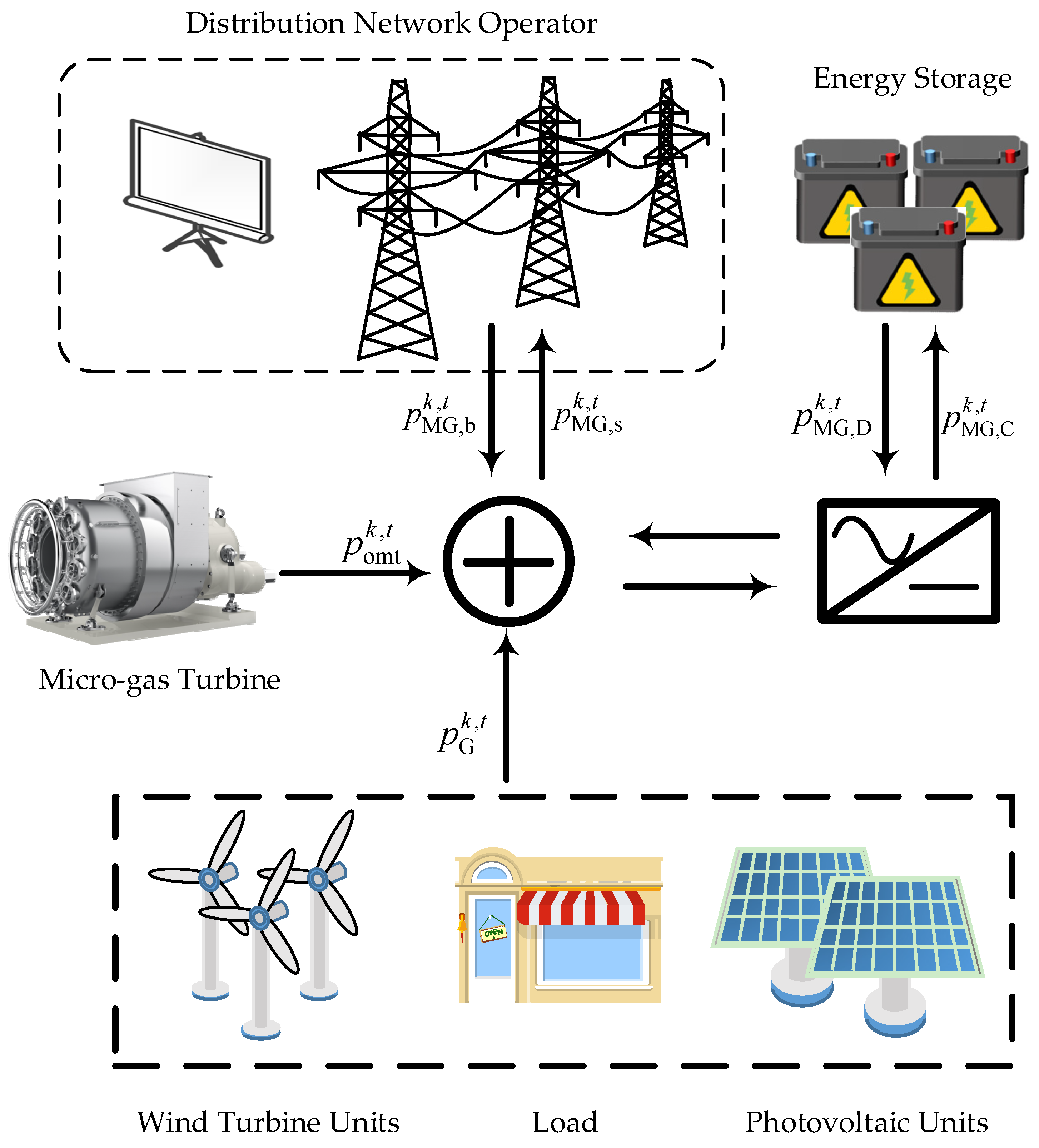
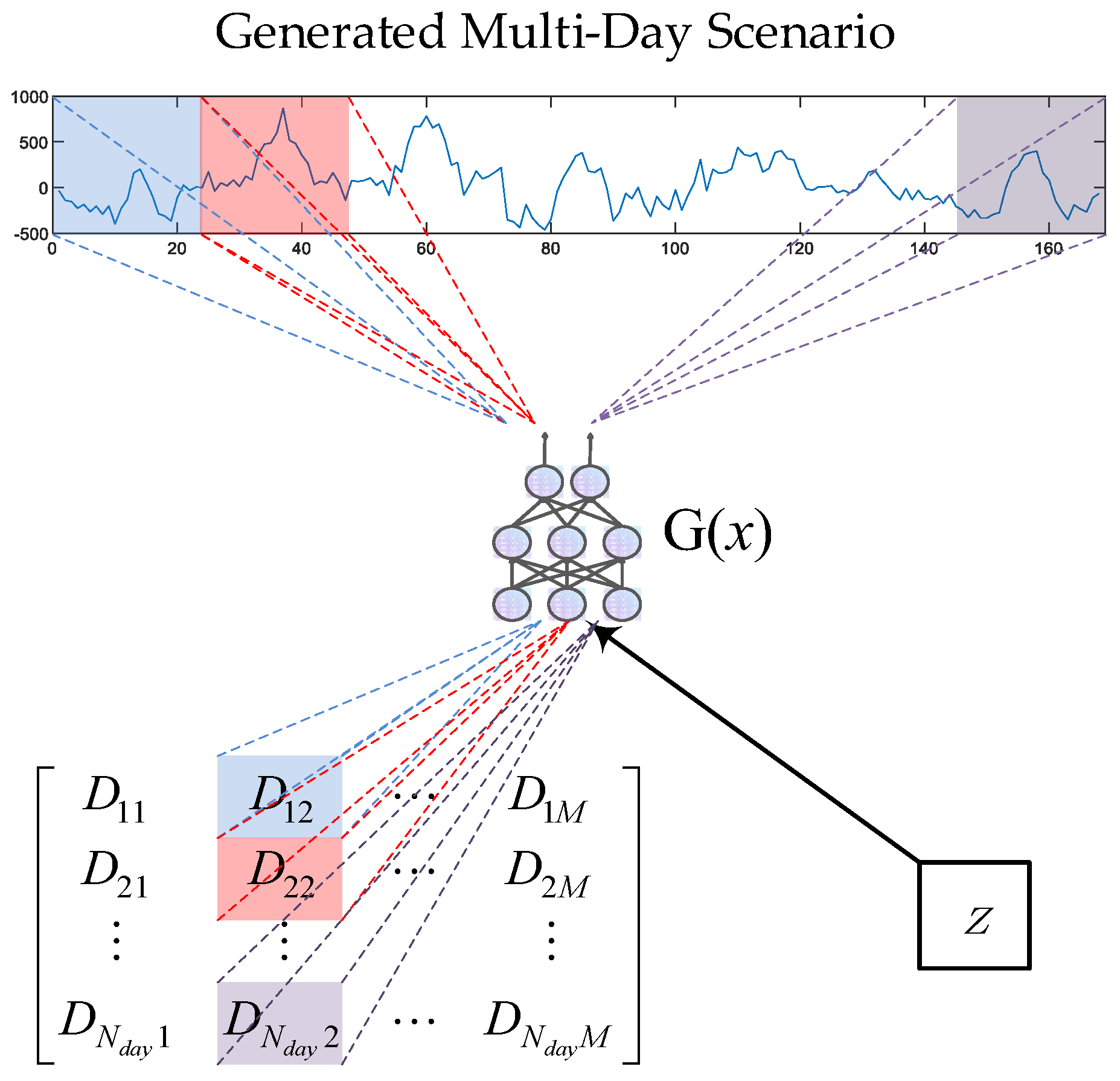
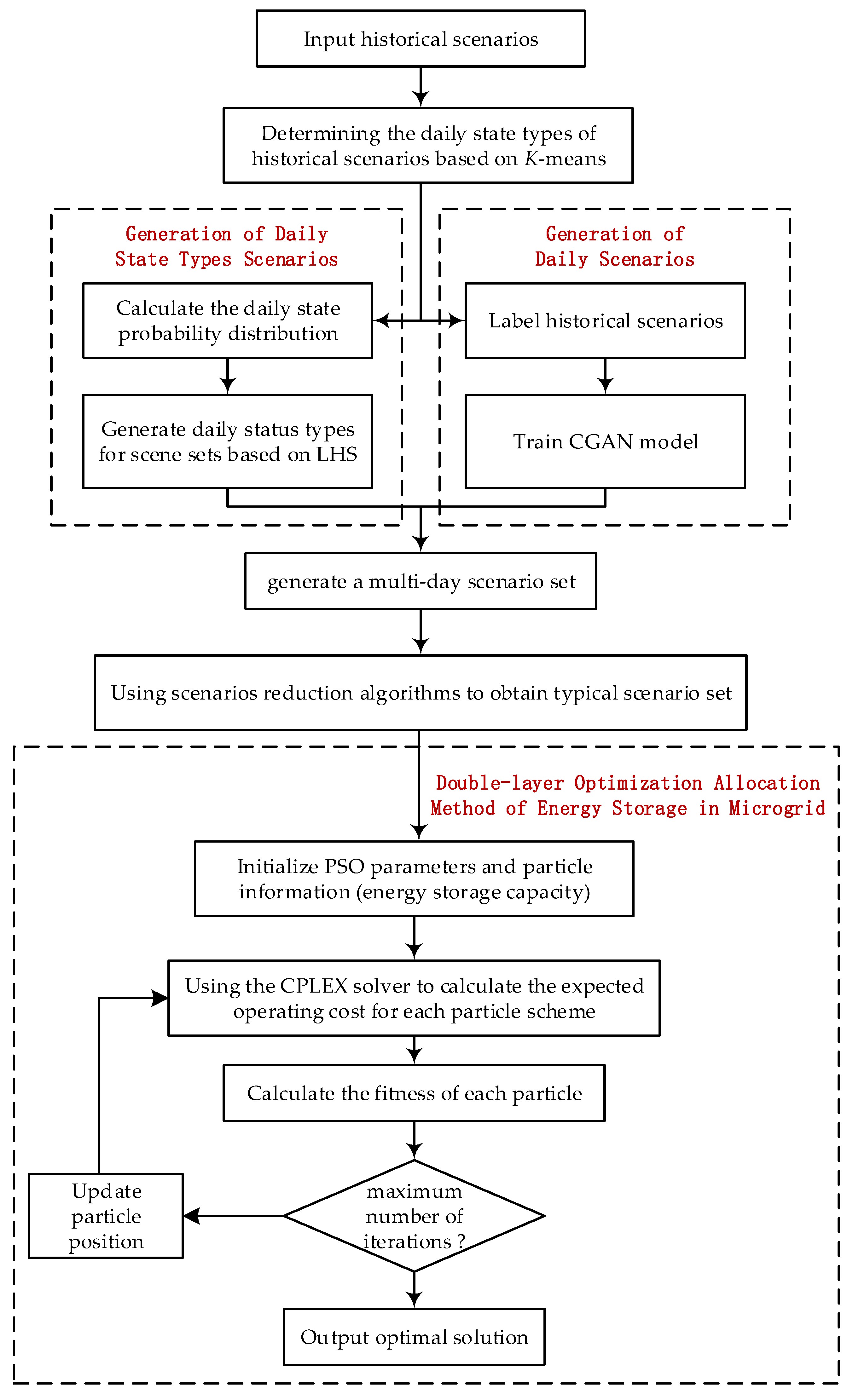

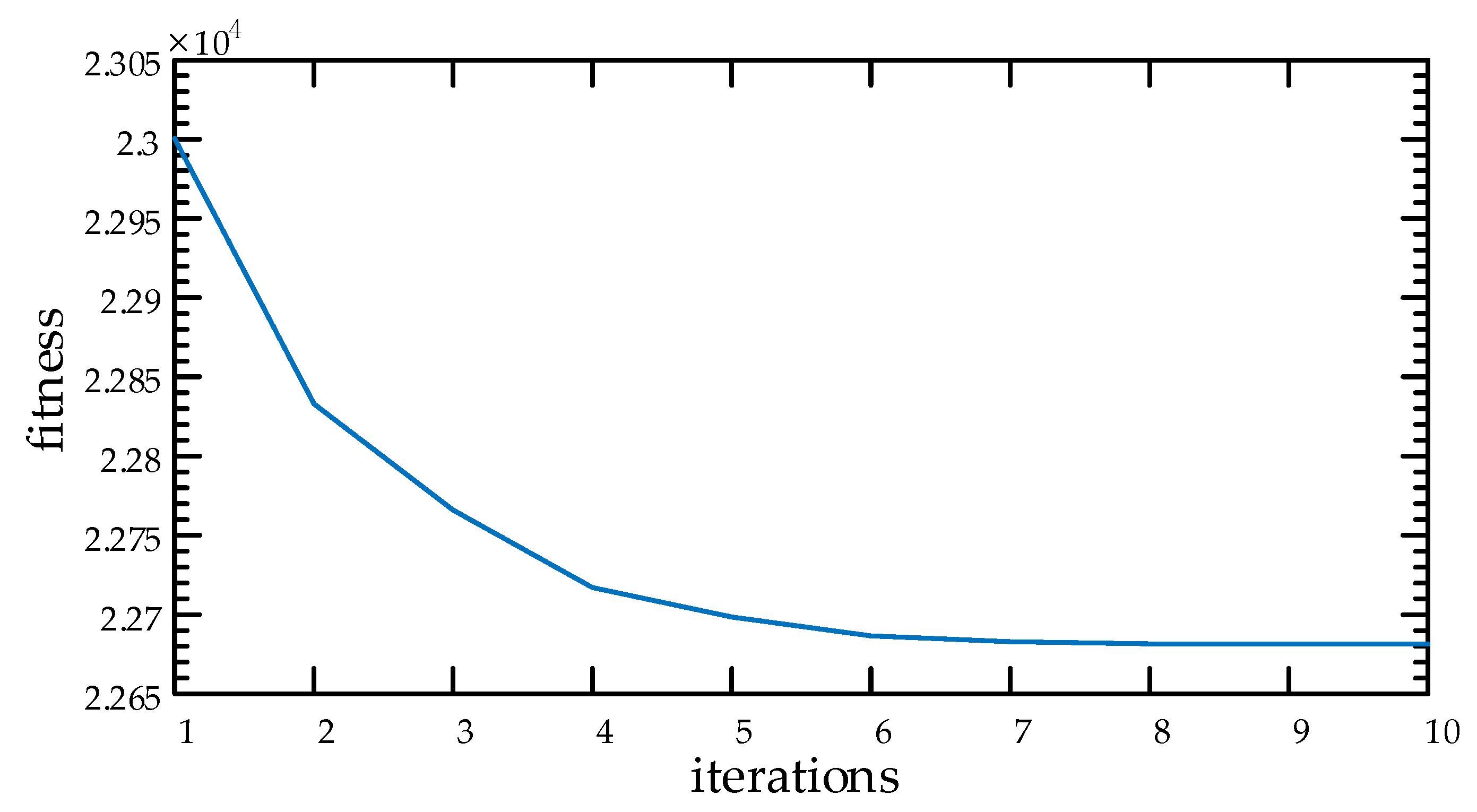
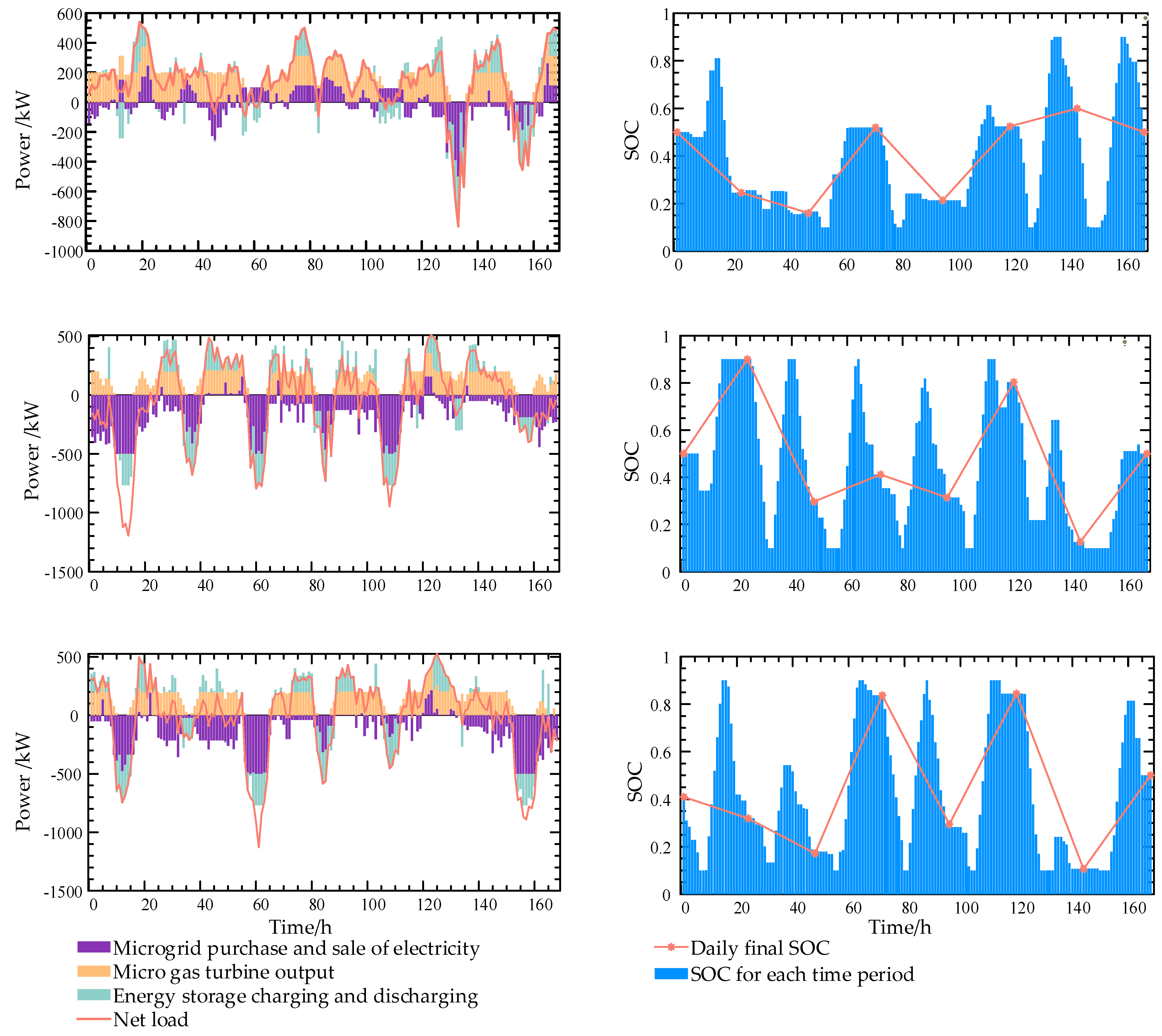
| Number of Reserved Scenarios | Expected Probability/% | ||
|---|---|---|---|
| Daily State 1 | Daily State 2 | Daily State 3 | |
| 3 | 42.85 | 33.33 | 23.81 |
| 5 | 34.28 | 42.86 | 22.85 |
| 10 | 28.57 | 38.57 | 32.56 |
| Number of Reserved Scenarios | Expected Probability/% | ||
|---|---|---|---|
| Daily State 1 | Daily State 2 | Daily State 3 | |
| 3 | 28.57 | 38.10 | 33.33 |
| 5 | 28.57 | 34.29 | 37.14 |
| 10 | 25.71 | 38.57 | 35.71 |
| Mean Square Error of Contact Line Power/kW2 | ||
|---|---|---|
| Before Microgrid Suppression | After Microgrid Suppression | |
| Typical Scenario 1 | 46,276 | 13,066 |
| Typical Scenario 2 | 137,515 | 26,424 |
| Typical Scenario 3 | 121,507 | 27,816 |
| /kWh | /kW | Average of Mean Square Error of Contact Line Power/kW2 | Wind and Photovoltaic Abandonment Power/kWh | Average Annual Total Cost | |
|---|---|---|---|---|---|
| Method 1 | 1168.9 | 217.4 | 2,181,846.5 | 110,091.6 | CNY 574,050.4 |
| Method 2 | 1546.4 | 250.0 | 1,896,224.6 | 86,019.2 | CNY 513,249.3 |
| Method 3 | 1804.5 | 269.0 | 1,736,419.9 | 72,973.4 | CNY 479,736.0 |
Disclaimer/Publisher’s Note: The statements, opinions and data contained in all publications are solely those of the individual author(s) and contributor(s) and not of MDPI and/or the editor(s). MDPI and/or the editor(s) disclaim responsibility for any injury to people or property resulting from any ideas, methods, instructions or products referred to in the content. |
© 2023 by the authors. Licensee MDPI, Basel, Switzerland. This article is an open access article distributed under the terms and conditions of the Creative Commons Attribution (CC BY) license (https://creativecommons.org/licenses/by/4.0/).
Share and Cite
Wei, W.; Ye, L.; Fang, Y.; Wang, Y.; Chen, X.; Li, Z. Optimal Allocation of Energy Storage Capacity in Microgrids Considering the Uncertainty of Renewable Energy Generation. Sustainability 2023, 15, 9544. https://doi.org/10.3390/su15129544
Wei W, Ye L, Fang Y, Wang Y, Chen X, Li Z. Optimal Allocation of Energy Storage Capacity in Microgrids Considering the Uncertainty of Renewable Energy Generation. Sustainability. 2023; 15(12):9544. https://doi.org/10.3390/su15129544
Chicago/Turabian StyleWei, Wei, Li Ye, Yi Fang, Yingchun Wang, Xi Chen, and Zhenhua Li. 2023. "Optimal Allocation of Energy Storage Capacity in Microgrids Considering the Uncertainty of Renewable Energy Generation" Sustainability 15, no. 12: 9544. https://doi.org/10.3390/su15129544
APA StyleWei, W., Ye, L., Fang, Y., Wang, Y., Chen, X., & Li, Z. (2023). Optimal Allocation of Energy Storage Capacity in Microgrids Considering the Uncertainty of Renewable Energy Generation. Sustainability, 15(12), 9544. https://doi.org/10.3390/su15129544







